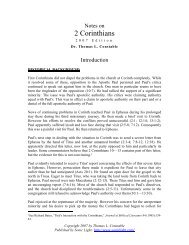1 Samuel - Odessa, Missouri Community of Christ
1 Samuel - Odessa, Missouri Community of Christ
1 Samuel - Odessa, Missouri Community of Christ
Create successful ePaper yourself
Turn your PDF publications into a flip-book with our unique Google optimized e-Paper software.
26 Dr. Constable's Notes on 1 <strong>Samuel</strong> 2007 EditionMost <strong>of</strong> the Israelites evidently thought that since Israel had lost the ark she had lostGod. 69 However, because the people had not lived in proper covenant relationship withHim, Israel had only lost God's blessing. They were disregarding God's Law, so God'sglory had departed from Israel (v. 22; cf. Exod. 19:5-6; Ezek. 10). His people could notenjoy fertility.Someone has said that if you feel far from God, you need to remember that He is not theone who moved. God has promised that if His people will draw near to Him He will drawnear to them (2 Chron. 7:14; James 4:8; Heb. 10:22).B. PAGAN FERTILITY FOILED BY GOD CH. 5The primary purpose <strong>of</strong> this chapter, I believe, is to demonstrate the superiority <strong>of</strong>Yahweh over Dagon, the fertility god <strong>of</strong> the Philistines. 705:1-5 Having captured the ark, the Philistines brought it from Ebenezer to theirmain city, Ashdod, which stood about 30 miles to the southwest and threemiles from the Mediterranean coast. Archaeologists have excavatedAshdod more extensively than any <strong>of</strong> the five major Philistine cities.Dagon was the principle deity <strong>of</strong> the Philistines. The popular teaching thatthe Philistines pictured him as being part man and part fish rests on verse4. Dag in Hebrew means fishy part. Dagon (cf. Heb. dagan, grain) was agrain god whom the Philistines worshipped as the source <strong>of</strong> bountifulharvests (fertility). Worship <strong>of</strong> him began about 2500 B.C. inMesopotamia, especially in the Middle-Euphrates region. 71The writer clarified that the Philistines regarded the fact that the imagerepresenting Dagon had fallen on its face before the ark as indicatingYahweh's superiority. Falling on one's face was a posture associated withworship. The fact that the Philistines had to reposition the idol is anotherallusion to Dagon's inferiority. He could not act on his own (cf. Isa. 46:7).Later Goliath, the Philistine champion, would also fall on his face beforeDavid, Yahweh's champion (17:49).The following night the symbol <strong>of</strong> Dagon toppled again before the ark, thesymbol <strong>of</strong> Yahweh. This time Dagon's head, symbolic <strong>of</strong> his sovereigncontrol, and his palms, symbolic <strong>of</strong> his power, broke <strong>of</strong>f (v. 4). In theancient Near East, warring armies cut <strong>of</strong>f and collected the heads and69 For a further discussion <strong>of</strong> the role <strong>of</strong> the ark at this time in Israel's history and how <strong>Samuel</strong>'s ministryrelated to it, see Clive Thomson, "<strong>Samuel</strong>, the Ark, and the Priesthood," Bibliotheca Sacra 118:417 (July-September 1961):259-63. For a more critical study <strong>of</strong> the ark, see P. R. Davies, "The History <strong>of</strong> the Ark inthe Books <strong>of</strong> <strong>Samuel</strong>," Journal <strong>of</strong> Northwest Semitic Languages 5 (1977):9-18.70 There are several similarities between this chapter and the record <strong>of</strong> God sending plagues on theEgyptians (Exod. 7—12), an earlier demonstration <strong>of</strong> His sovereignty.71 New Bible Dictionary, s.v. "Dagon," by Kenneth A. Kitchen.








